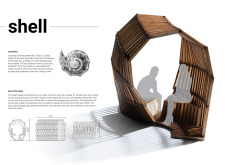5 key facts about this project
The project titled "Shell" is located in Tokyo, a city deeply connected to the sea due to its history as a fishing settlement. The design serves as a protective space for individuals, inspired by the natural armor of deep-sea creatures. The aim is to create a refuge from the busy urban environment while also encouraging interaction with the surroundings.
Concept and Form
The cabin has a twisted shape that resembles a shell. This form is both visually interesting and practical. It offers users a feeling of safety, inviting them to engage in quiet reflection. The design fits well within the natural landscape, echoing the shapes found in nature.
Openwork Design
One of the key features of the cabin is its openwork structure. This allows light to enter while providing separation from the outside crowd. The result is a peaceful environment that encourages introspection. Users can also observe the vibrant world outside, adding to their experience of solitude.
Seating Arrangement
Inside, the seating is arranged diagonally across from each other. This layout promotes direct communication between occupants. In today’s digital age, where face-to-face conversations are reduced, this arrangement fosters deeper connections. It allows people to engage with one another in a quiet, sheltered setting.
Material Considerations
While the presentation does not specify materials, the design suggests the need for lightweight and durable options. Such materials would support the structural goals of the cabin, helping it endure the urban conditions while remaining unobtrusive in the environment.
Natural Integration
The essence of "Shell" is its balance between comfort and a connection to nature. It offers a calm space amidst the lively pace of Tokyo. The interaction of light and shadow through the openwork design enhances the bond between interior and exterior, highlighting how the form engages with the natural world.



















































